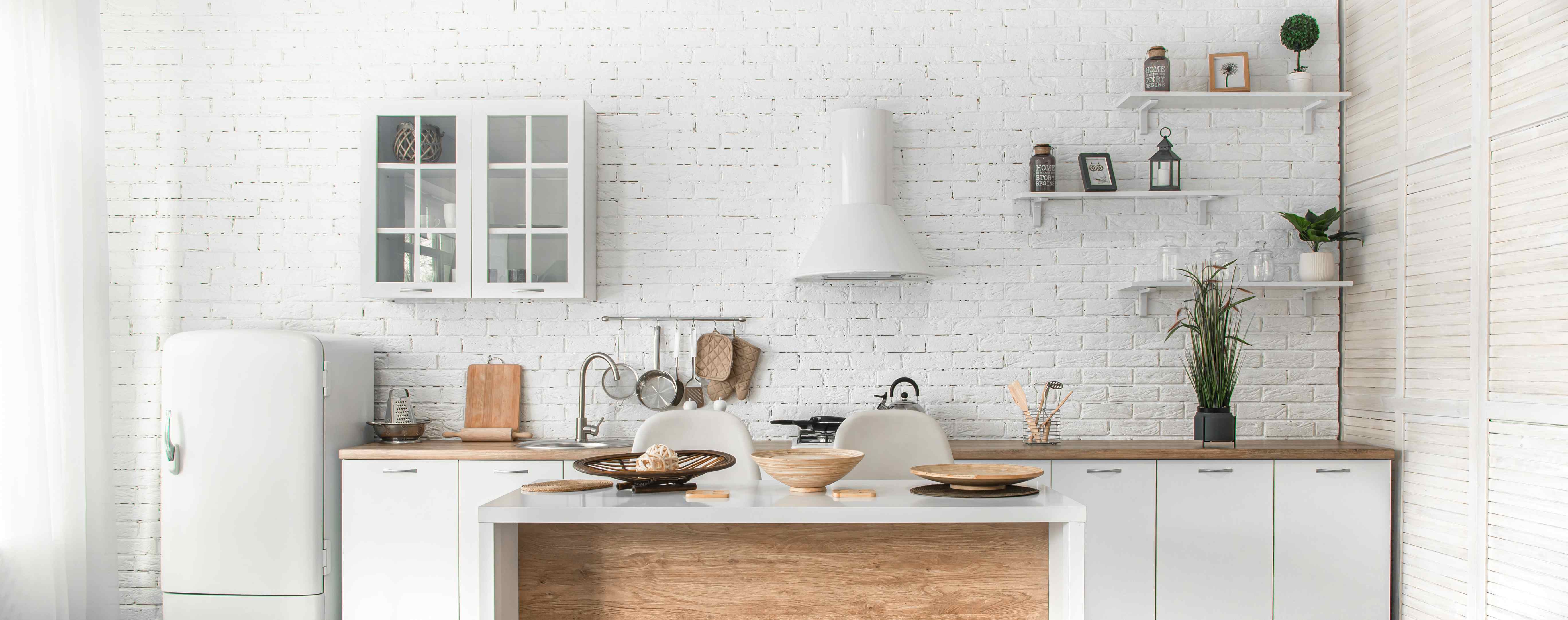In 2020, we all got to spend a lot more time in our homes. During that time, did you start to realize your home might need a face lift? Maybe you noticed that your kitchen is outdated or that your flooring has, shall we say, seen better days? If you’re interested in updating your home, you may have wondered: What is remodeling and how do I do it?
Remodeling 101
If you’re not a general contractor, home project terminology can be tricky. Home improvement shows use terms like “renovation,” “home improvement,” and “remodeling” all the time. To the layman, these seem interchangeable, while in fact, they each have unique definitions.
Remodeling
The definition of remodeling is “to change the structure or shape of something.” Rather than simply giving your home its summer bod, you’re doing an overhaul on layout and appearance. This includes repairs or updates that improve the structure and layout and could include a few cosmetic touches as well.
One reason to do a full remodel versus a renovation or home improvement project is to change the function of a room. Maybe you want to open up a space and bust down some walls? That’s a remodel! You’re transforming the layout and design. In a way, a remodel makes you the fairy godmother, and your home is the pumpkin she turns into a carriage.
As you rework and transform your home, some rooms might look totally different. Have all the kids moved out and you need a man cave or a she shed? You could remodel an existing room to change the function and make it virtually unrecognizable. That’s the beauty of a remodel; the possibilities are endless.
Some examples are:
- Removing walls
- Overhauling a bathroom
- Reworking the kitchen layout
- Converting a basement
- Building an addition
Renovations
The definition of renovation is to restore something back to its original glory, or at least to a state of good repair. These changes might be less obvious because you’re essentially improving a part of your home without altering the the original structure.
Let’s say you buy a fixer-upper. You love the home’s layout and don’t necessarily need to gut it. Instead of a full remodel, you would likely end up doing a renovation.
A renovation is a good option for older buildings, homes that haven’t been well maintained, or something in disrepair.
Some renovation projects you might be familiar with are:
- Refacing kitchen cabinets
- Laying down new flooring
- Adding new hardware
- Replacing windows
- Switching out your front door
Home Improvement
One of the side effects of watching home improvement shows is that you get bit by the DIY bug. Suddenly, you’re the expert on painting a room, laying down new flooring, or retiling a bathroom.
Okay, you’re not the expert. But for a home improvement project, you don’t necessarily have to be. The core concept of a home improvement project is to improve your existing home – often in small and simple ways. You’ll often be able to DIY these projects.
A good way to think of home improvement projects is to think of things you could do in a weekend, like:
- Painting a room
- Changing light fixtures
- Hanging wall shelves
- Installing a closet organization system
- Updating plumbing fixtures
Benefits of Remodeling
Remodeling is a huge undertaking, so why would homeowners do it? Well, extra effort produces extra reward! Home remodels might be a lot of work, but they’ll completely change the look, feel, and function of your space.
For example, look at the impact of a kitchen remodel. Of course, this will improve the overall aesthetic of your home, but did you know it could actually improve your health?
A recent report by Houzz found that one-third of homeowners who did a kitchen remodel said they lived a healthier lifestyle after their new kitchen was done. Check out these statistics about the impact of a kitchen remodel:
- 76% of homeowners said they started eating at home five or more days per week.
- 34% said they started eating less takeout.
- 30% said they started baking more.
- 29% found they were having more sit-down meals
- 26% started eating more fruits and vegetables

Rather than starting another crash diet, a kitchen remodel might be the first step in creating the healthy lifestyle you’ve been dreaming of. But the benefits don’t end in the kitchen:
- More family time
- More “me” time
- Better connections
- Energy efficiency
- Save yourself a move
- Improve your home’s value
- Customize your home
- Upgrade your home
- Make the house more functional for you
Whatever your motivation is for a remodel, there’s always a huge return on your investment – either monetary, lifestyle, or emotional.
Signs Your Home Needs a Remodel
Knowing when to pull the trigger on a remodel is tricky. Because you live in your home, you become a little blind to outdated features and non-functional spaces. Here are some things to look for that will tell you it’s time for a remodel:
Issues with Free Space
Did one of your kids move back home? Or have they all flown the nest, leaving the house empty? Perhaps you just want to open up an area or two for some extra breathing room? A remodel gives you the chance to reclaim your space, whether there’s currently too much or too little.
Flooring Needs to Be Replaced
Your flooring will sadly come to the end of its life one day. Look down; is your flooring damaged, dingy, or dated? Then it’s time to consider a remodel. You’d be surprised at how slapping down some new flooring completely transforms a space. Plus, you might like the feel of soft carpet in the winter or the look of hardwood filling your entryway. There’s more to flooring than just aesthetics!
Outdated Bathroom Fixtures
The pastel sink, the matching colored toilet, the grungy tile: Your bathroom’s fixtures date your house because they were likely installed when the home was first built or during the last remodel. If they’re outdated, it’s time for an upgrade. Go ahead; wash the 20th century out of your home.
Rough-Looking Paint
Whether it’s outside or inside, if your paint is starting to crack, fade, or stain, it’s time to fix it. What good is remodeling if your home’s makeup looks off?
Termites and Pests
They don’t pay rent, and they can damage your home. Termites and pests aren’t just gross; they can lead to safety and health concerns. If the termites are extra bad, you’ll have to tear down walls and replace structural components anyway. What better time to update your home than when you’re evicting these deadbeat tenants?
Leaky Roof
A leaky roof leads to moisture damage, rot, and even mold. These structural issues appear quickly, even from the smallest leaks. If you notice any moisture in your attic or ceilings, there’s no time to waste. Start your home remodel right away to stop the damage from getting worse.
Outdated Appearance
You know those people that have had the same haircut for decades? Just like them, your home might simply look a little dated. That green and mustard kitchen isn’t doing you any favors in 2021. To bring your home into the modern era, remodeling is the answer.
Flickering Lights
Another serious reason to remodel is flickering lights. This can be an indication of electrical issues. If an electrician needs to expose your wires for a repair, it might be the perfect opportunity to swap out an outdated light fixture, move around walls, and revamp your space.
Non-Functional Spaces
When you moved into your home, you inherited the spaces from the previous owners. But what worked for them might not work for you. Maybe you prefer one open area instead of multiple tiny rooms? Create a more functional space that’s customized to your needs.
Drainage Problems
If you have plumbing issues, you could end up in a stinky situation faster than you realize. You also run the risk of mold moving into your house. Don’t wait; schedule the remodel.
If You Plan on Staying
If you don’t plan on moving anytime soon, why not just fix all those little things that have been bugging you and transform your space into your forever home? Waiting will only mean less time for you to enjoy the updates.
Things to Consider Before a Remodel
Okay, you’re ready for a remodel. But before the hammers start swinging, there are a few things to consider:
- Potential return on investment
- Local building permits
- Family impact
- Energy needs
- Cost of remodeling vs. the cost of a new home
As you’re deciding whether a remodel is right for you, be realistic about what remodeling is going to do to your life. Looking at these factors through a realistic lens can help you decide when and how to start your project.
How to Budget for a Remodel
A remodel can cost thousands of dollars – sometimes tens of thousands – so it’s important to know how much you’ll have to pay, where the money is going, and what kinds of returns you’ll get on your investment. There’s nothing worse than running out of money in the middle of a remodel, so it’s essential to plan your budget accordingly.
Cost of a Remodel
It’s difficult to answer the question “What is remodeling going to cost me?” Every project is different. A kitchen remodel is a whole other beast compared to changing around a bedroom.
While it’s impossible to guess exactly how much your unique project will cost, here are the national average home renovation costs by room to give you a general idea:
- Kitchen = $23,556
- Bathroom = $10,349
- Laundry Room = $6,000
- Bedroom = $7,880
- Basement = $15,000
- Living Room = $7,264
- Attic = $49,438
Remember, the cost can add up quickly, depending on your taste and the materials. Even the season can have an impact on the price tag. The average bathroom reno might be around $10,000, but if you have expensive taste – or a gigantic bathroom – you might pay double that.
Before starting your project, make sure you get a detailed quote from the contractor. If you’re doing a DIY renovation, build out your materials list ahead of time, including prices. That way you can get an idea of the total project cost before committing.
Where Is the Money Going?
This is another question that has a difficult answer. Typically, you should expect to spend about one-third of your budget on labor and two-thirds on materials. That being said, your materials cost can rise faster than gas prices if you have expensive taste.
Creating a Remodeling Budget
Saying you need a budget is far easier than actually creating one. For many homeowners, it can feel like your budget is just a ton of guesswork. While that’s true to an extent, there are some ways to have a clearer idea of what a project will cost.
Here’s how to create a remodeling budget that you can actually stick to:
Know How Much to Spend
A good rule of thumb is spending no more than 10 to 15 percent of your home’s value on a single room, including all materials and labor. Keeping it in that range will ensure the greatest return on your investment.
Needs Versus Wants
You might want a closet that could double as a shopping center, but making that vision a reality can cost a ton of money. Assessing what you need versus what you want will help keep your goals for the remodel realistic. If you’re running low on money for the project, cut back on some of the wants, so you can guarantee your needs are met.
Know the Return on Investment
Any home improvements will have an impact on your home’s value. The extent of the impact depends on the room, what you do, what materials you use, and the comps in your neighborhood. Doing the research to know the return on investment can help put your cost of the remodel into perspective.
Know the Room Specs
Remodeling a 750-square foot apartment is different than working on a sprawling five-bedroom home in the suburbs. Knowing your home’s specs – and the size of each room – will help you anticipate costs. Obviously, the bigger the room, the bigger the cost.
Get Multiple Bids
If you want a clearer idea of what a project will cost (and who doesn’t?), get multiple bids. Ideally, aim for around ten quotes. That might seem insane, but with that many bids, you can easily compare industry averages for your particular project, rather than guessing. It’ll give you a better idea of what the project should actually cost, instead of simply taking the contractor’s word for it – which you should never do!
How to Save on a Remodel
You do the work to figure out how much your remodeling project will cost. The number is astounding. Suddenly you’re in a mental tailspin, questioning every decision you’ve ever made as you try to figure out how you’ll pay for this project!
Stop panicking. A home remodel will help you create the perfect living space (and how can you put a price tag on that!?). Besides, there are dozens of ways to save money. Even doing a couple little things can cut your costs significantly. Here’s a few ways how you can save money on a home remodel:
Stick to the Budget
Things come up during a remodel that inflate the cost, like finding the most perfect faucet you’ve ever seen or changing your mind about the flooring. Unfortunately, every time you call and audible on the plans, your bill goes up. Stick to the budget, and you’ll find yourself making better decisions.
Save on Materials
Some building materials can be sourced from places other than the hardware store. Check online marketplaces for deals on materials left over from other contractors. It might take a little extra work, but it could save you tons of money in the end.
Find Good Deals on the Essentials
Hardware stores run sales on almost everything; you just have to wait for them. As difficult as it can be, showing some patience can pay off in the long run. Waiting for those fancy drawer pulls to go on sale could save enough money to get the mirror of your dreams.
Pay Cash
Whether for materials or paying your contractor fees, you can sometimes get a deal by simply paying with cash. At the very least, offer it. You might be surprised what people are willing to accept when cash is an option.
Don’t Rush It
If you’re constantly pushing your contractor to finish things faster, you’re setting yourself up for mistakes. These will have to be corrected, costing more in materials and labor.
Your contractor knows what they’re doing. As long as they’re not months behind, let them do their thing. Just be patient. You’ll be able to enjoy the updates for the rest of your time in the home. What’s another day or so?
DIY Where You Can
For major aspects of a remodel, like structural components, absolutely let a professional handle it. But there are plenty of smaller projects you can handle yourself, saving money on labor.
For example, let the contractor hang the drywall, but paint it yourself. That’s a small task that doesn’t take years of experience to figure out.
Shop Around for Contractors
Another reason to get so many bids is to shop around for the right contractor. It might not be a good idea to go for the cheapest contractor on the list, but you’ll at least get a spectrum of quotes and experience levels for you to choose the one that’s right for your unique home project.
Sell the Appliances You Plan to Replace
If you’re remodeling a room like your kitchen, don’t just throw out your old appliances. If they still work, try to sell them to add some funds to your remodel project. Even if you sell them just for the parts, it could offset the project cost by hundreds.
Check Your Insurance Coverage
If one of the workers hurts themselves on your property, your cost could skyrocket. Make sure that doesn’t happen by checking you general contractor’s insurance policy. Be sure there’s at least general liability insurance, so you’re not responsible for huge medical bills in addition to the total project cost.
Stick with Standard Sizes
As tempting as custom cabinetry or flooring can be, if you stick with standard sizing, you’ll save big time. Plus, it’ll be easier to repair or replace if something does go wrong. You can just tell everyone they’re custom. Who really knows standard cabinet sizes, anyway?
Look for Dupes
Love the look of something but the cost has you clutching your pearls? Find a dupe. There are tons of items out there designed to look like high-end materials but without the massive price tag.
For example, the look and feel of hardwood flooring is unparalleled, but it’s also very expensive. Instead, opt for vinyl or laminate flooring designed to look like hardwood flooring. You’ll save money but get the same fancy look.
Maximize Space Before Enlarging
If the tiny home trend has taught us anything, it’s that maximizing space can make a big difference. Instead of enlarging a space – something that can make your costs balloon quickly – consider ways to maximize your space first. You’d be surprised at how moving furniture, reorganize cabinets, or choosing specific paint colors can make your space look huge without busting down walls.
Don’t Move Plumbing
When remodeling a room with plumbing, find a way to keep all the pipes where they are. If you can remodel to your liking without moving things like sinks, faucets, shower heads, and water lines in their place, you’ll spend a lot less. Removing and reinstalling plumbing is one of the most expensive parts of a home remodel. If you can help it, just leave it where it is.
Have a Slush Fund
Even the most accurate budget possible is no match for the surprise costs. Something will come up that costs you extra, and you need to prepare for it. Have a slush fund in place to handle these added expenses. Most professionals recommend setting aside 10% to cover unforeseen costs.
Time It Right
Remodeling during certain times of the year will cost more than others. Many contractors are busy in the summer, so their price will go up. If you schedule your remodel for the colder months, you’ll cut down your bill considerably.
Hiring a Contractor
With your budget in place, it’s time to hire a contractor. But it’s not as simple as calling them on the phone and asking them to start tomorrow. There are steps to take before, during, and after that initial phone call to ensure the project goes smoothly.
Before You Call
Before you ever pick up the phone to call a contractor, there are some things you should already know or have decided about your project:
- Know what you want to remodel.
- Understand which permits (if any) you’ll need.
- Have a way to pay for your remodel:
- Cash
- Credit
- Loan
- Equity
- Have a general idea of the total cost of the project.
- Ask friends and family for recommendations.
If you have these points figured out, the call will go smoother – and you’ll sound a lot cooler to a prospective contractor.
Questions to Ask
Have you ever hung up the phone and realized you forgot to ask an important question or two? When it’s something as important as hiring a contractor to tear apart your house, don’t let that happen.
Write down a list of questions you want them to answer about the project before you pick up the phone. Here are a few general questions you should always ask a contractor before starting a home renovation project:
- Will the bid be itemized?
- Is your bid an estimate, or is it fixed-price?
- How long have you been in business? In this town?
- Which suppliers do you use?
- Is the foreman available to meet before the project?
- In the last year, how many projects like this did you do?
- Which permits will we need?
- May I see your references?
- As for insurance, what policies do you have? What’s the coverage?
- Will subcontractors be involved in the project?
These questions will give you a clear idea of the experience level of your contractor, their dedication and attention to your project, and what you can expect about how the project will be completed. Then you’ll need to understand the bids.
Understanding Bids
As you start receiving bids, you’ll need to compare them. Even more importantly, though, you have to understand them. There are two types of bids: Estimates and fixed-price.
Estimates
An estimate includes an itemized list of every single solitary labor and material expense. You’ll also see a contractor’s fee. With an estimate, the fee is a percentage of the total cost of the project. Itemized bids tend to have a higher risk for escalating costs because the contractor makes more if the project costs more.
For example, if the flooring material you select costs $3 per square foot and you’re covering a 100-square-foot area, it’ll cost $300. If your contractor talks you into flooring that costs $5 per square foot, it will cost $500.
Because the contractor makes a percentage based on the total costs of the project, they’ll also get more of a commission off the $500 job than the $300 one. They have more incentive to convince you to buy the more expensive flooring. Pay attention to how this variable fee will impact your total cost.
In spite of the variable contractors fee, estimates are the most transparent bid you can get. These are the most common bids for larger projects, like additions or building a home. They’re also the easiest to compare.
Fixed-Price
As the name would suggest, a fixed-price bid has a flat-rate cost for the project based on the contractor’s assessment of the project as a whole. It’s most common for smaller projects, like installing appliances, flooring, or small repairs.
While a fixed-price bid is based on giving you a single rate that won’t change based on labor or materials, it will have a contingency built in. The contingency is essentially a markup that protects the contractor in case the cost of materials goes up significantly.
Returning to our flooring example, if you choose a hardwood floor and at the time of the bid, it costs $4 per square foot, your contractor will create their fixed-price bid based on that. But what happens if the cost of lumber goes up to $6 per square foot?
With a fixed-price bid, the contingency protects the contractor from eating into their profits too much with the rising cost of lumber. In a way, it also protects you from costs inflating and the total final price going up.
Because of the nature of fixed-price bids, you’ll be consulted on any changes made to the plans. While that should bring you some comfort, it’s important to be aware how each change impacts the contingency. It does have a limit.
A downside to a fixed-price bid is that a less-than-stellar contractor might be tempted to cut corners. If they choose cheap materials, they can make more profit in the end.
Another downside is that fixed-price bids are harder to compare, since they aren’t as in-depth or detailed as an estimate. You’ll be able to compare only the fixed-price you’re being quoted, not the individual items or labor.
Tips for Surviving a Home Remodel
Knowing the ins and outs of planning and paying for a remodel is only part of the process. You also have to survive it.

There’s no denying it: A remodeling project will affect your day-to-day life. But there are things you can do to mitigate the impact.
Plan Well
Not only do you need to plan logistics, you need to plan for disruptions to your life. Know ahead of time how long a contractor expects the project to take and plan your schedule around the remodel. You might even need to find a place to stay if the project is extensive.
Choose the Right Season
If you choose to remodel during the winter, you’ll save money. However, a winter remodel could make your home unlivable. It’s no fun to stay in a cold house with no walls or insulation – depending on your project. If you’re replacing features that impact your home’s ability to keep out the cold, maybe it’s worth it to bite the monetary bullet (so to speak) and get a summer remodel. At least you won’t have to worry about pipes freezing!
Declutter
To reduce the amount of chaos, declutter your home. Have a yard sale, and donate as much as you can. This will give the contractors more space to work. Besides, who couldn’t use a little bit of declutter once in a while?
Rent a Storage Container or Storage Unit
Removing as much stuff from the area as you can will make a big difference. It’ll help the project go much more smoothly, reducing timelines and preventing damage to your stuff. If you don’t want to sell your stuff, renting a storage container or storage unit is a great alternative to get your things out of the way without getting rid of them for good.
Plan for Babysitting and Pet Sitting
If you have little ones – four-legged or human – plan to leave them in a safe place during the large parts of your home renovation. Lining up babysitting or pet sitting can reduce the stress in your home and save sensitive ears from loud construction.
Air Quality
Dust, debris, and fumes are a big part of a home remodel, so make sure you plan for them. You can rent an air scrubber with a HEPA filter to keep everyone comfortable and safe as contractors give your home its facelift.
Plan for Rooms to Be Unused
If you’re planning for a kitchen or bathroom remodel, plan on these rooms being unusable for the length of the project. Either lineup accommodations elsewhere, or create back-up options within your home, like renting portable toilets or setting up a makeshift kitchen in another room of your home.
Plan for Mess
Breaking news: remodeling is messy. It’s imperative that you mentally prepare for the chaos. If you’re a particularly tidy person, invest in some soothing candles or yoga classes to mitigate the stress a messy remodel might bring.
Communication is Key
Having strong lines of communication with your contractor is crucial. Set a standard for the communication you expect from the moment you first interact with a contractor, and maintain that communication throughout the remodel. Make sure you’re in the loop throughout the entire process.
Ready for Your Remodel?

Compare Quotes from Top-rated Remodeling Contractors in your area.
A home remodel doesn’t have to be stressful. It’s a chance to revitalize your life and home, giving you a fresh space to make memories and build your life. All it takes is some planning and creativity on your part.
To get inspiration for your home remodels, check out our inspiration section. There, you’ll find ideas for making your kitchen, living room, bathroom, or bedroom magazine-quality gorgeous.
Ready to get started? We can help! Just give us an idea of what you want to do and we’ll help you to get connected with top contractors in your area! Just Enter your zip here to get started!





Facebook
Comments